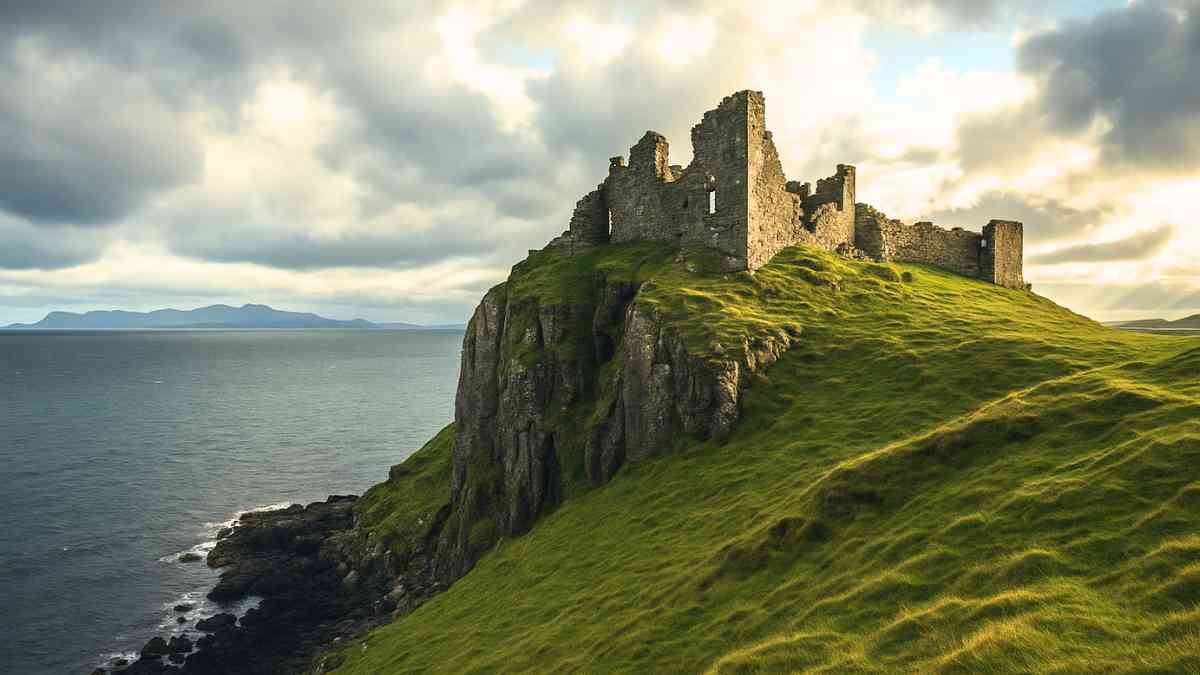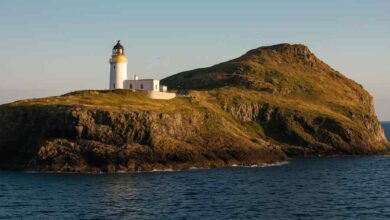Duntulm Castle: The Lonely Sentinel of Skye’s Rugged Beauty

Scotland is a land sculpted by myth, nature, and the bones of its own history. Among the most dramatic remnants of this history stands Duntulm Castle, an ancient stronghold that now slumbers on the wind-beaten cliffs of the Isle of Skye. Though its stone walls are crumbling and its halls silent, Duntulm Castle commands an eerie respect from all who visit. This is not just a ruin—it is a relic of the soul of Skye.
With no tourist shops or loud signs, Duntulm Castle Isle of Skye doesn’t shout for attention. Instead, it whispers. About power. About clans. About betrayal and isolation. And perhaps, if you stand still long enough, about ghosts.
The Origin and Rise of Duntulm Castle
Before the castle, there may have been a fort. Archaeologists believe the promontory once held a Pictish or Iron Age structure long before the Scottish clans made it their own. When the Norse controlled Skye, the site may have served as a defensive lookout over the Minch.
The castle as we know it began to take shape in the 14th century. It became central to the power struggles between two of Scotland’s most formidable clans: the MacLeods and the MacDonalds. After a period of brutal conflict, the MacDonalds eventually claimed Duntulm as theirs in the early 1600s.
In 1618, under the terms of a royal charter, Sir Donald MacDonald of Sleat—known as Donald Gorm Og—was compelled to fortify and restore the castle. It became a proper residence, and for a time, Duntulm Castle Skye flourished as a key stronghold in the region.
Architecture of Power: What Once Was
Today, visitors see only fragments, but once Duntulm Castle was a complex and layered structure. Its position was chosen with strategy in mind, seated atop a sheer basalt cliff that made invasion nearly impossible from the sea.
The original structure featured a four-story tower house with thick stone walls and an enclosed courtyard. Outer defenses were simple yet effective—natural cliffs on three sides and a man-made ditch on the landward side. In the 17th century, a rectangular house was added inside the walls, suggesting an attempt to modernize it for more comfortable living.
One of the most notable aspects was its isolation. There was only one narrow entrance, a cleft in the cliffside. Anyone who came to Duntulm did so with great purpose—or great caution.
Legends in the Stone: Hauntings and Tragedy
No castle in Scotland is complete without its share of ghosts, and Duntulm is no exception. One of the most chilling stories is that of the nursemaid who dropped a chieftain’s infant son from a window. For her carelessness, she was cast adrift at sea. Her cries are still said to echo in the wind.
Another tale speaks of Hugh MacDonald, imprisoned in the castle and left to die after a failed attempt to seize power. With only salted meat and no water, he is said to have gone mad with thirst. Some say his groans can still be heard near the ruins.
Even its decline has mythic overtones. Legend has it that a family member lost an eye in an accident at the castle, prompting the clan to abandon it out of superstition.
The Decline and Abandonment
By the early 18th century, the MacDonalds moved their residence to the more accessible Monkstadt House. Duntulm Castle, too isolated and battered by the elements, was left to decay. Its stones were repurposed for other buildings, its walls pulled apart by time and weather.
Yet even as it declined, the name Duntulm Castle Scotland remained etched into the legacy of the Highlands. Its ruins today are not a failure of architecture, but a natural return to the earth from which they were born.
Visiting Duntulm Castle: What to Expect
The journey to Duntulm Castle is part of the experience. Located about 26 miles north of Portree on the Isle of Skye, the castle sits along the breathtaking A855 coastal road.
There is no flashy signage. No crowded parking lot. Just a small lay-by near the site, from which a footpath leads through windswept grass to the edge of the cliff. The path is uneven and muddy in places, so sturdy shoes are essential.
You can’t step into the castle itself—it’s fenced off for safety. The structure is too unstable. But you don’t need to enter to feel its weight. Standing near it, with the Atlantic winds howling and the Hebrides on the horizon, is enough to connect you with the long arc of Scottish history.
A Castle with a Soul
Unlike more curated tourist attractions, Duntulm Castle offers something raw. Authentic. Here, you confront history in its naked form—uninterpreted, unsanitized. You walk the same path trodden by warriors, nobles, and exiles.
There are no brochures, no docents. Only silence and stone.
That’s what makes Duntulm Castle special. He does not ask to be remembered. He simply is.
Photography and the Elements
For photographers, Duntulm is a dream—and a challenge. The shifting weather on Skye means you may find the castle bathed in golden light one moment and cloaked in fog the next. Sunsets are especially stunning, as the last rays of light turn the stone walls amber against the silver sea.
Drones are not recommended due to strong winds and the protected nature of the site. But even a modest camera will capture something unforgettable if you wait for the right moment.
Nearby Attractions and Cultural Context
Though Duntulm feels isolated, it is surrounded by other points of interest. The village of Uig is not far away, and offers ferry services to the Outer Hebrides. You can also visit the Skye Museum of Island Life nearby for context about clan living and rural Scottish traditions.
For those tracing ancestral roots or passionate about Scottish history, Duntulm Castle provides an unfiltered glimpse into the harsh realities of Highland life.
It’s more than a photo stop. It’s a reckoning.
Preservation and Respect
Because the structure is fragile and at risk of further erosion, it’s crucial that visitors treat the site with respect. Stay behind the fencing, avoid climbing the ruins, and take only memories (and photos).
There is a quiet campaign by local heritage organizations to preserve what remains of the castle. Its cultural significance to Scotland’s heritage is unquestionable.
Conclusion
Duntulm Castle may not rise tall with turrets and banners. But it offers something much rarer: authentic silence and solemn dignity. Its ruined state is not a loss—it’s an invitation. To reflect. To imagine. To remember.
When you stand on that cliff and feel the Atlantic wind strike your face, you’re not just visiting a landmark. You’re communing with history.
In the end, Duntulm Castle Isle of Skye teaches us that the past isn’t always buried. Sometimes, it sits quietly by the sea, waiting for you to find it.
As visitors wander among the castle’s ruins, caressing the time-worn yet resilient stones, they hear whispers of history echoing in their ears. When the trip is over and people leave this magical land with full memories, they always hope to find a special way to treasure this precious experience forever.
Enamel Pins Custom has become an excellent choice. Custom enamel pins can be produced very quickly. These small and delicate pins can be meticulously designed to reflect the unique image of Duntum Castle or incorporate iconic elements of the Isle of Skye. When pinned to clothing or backpacks, these custom pins become more than just a decorative accessory; they become a walking memento, a vivid reminder of an unforgettable journey in Scotland, on the Isle of Skye, and at Duntum Castle.



